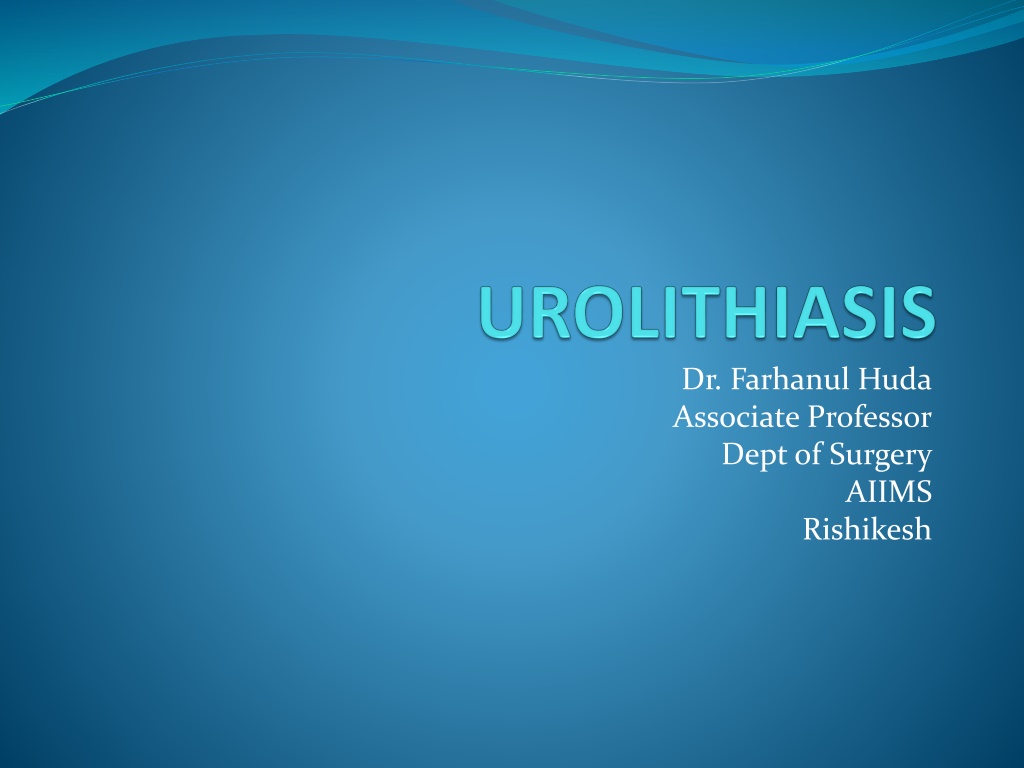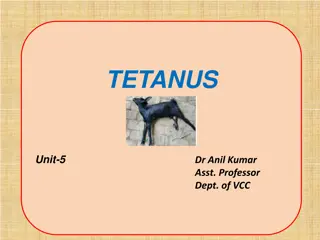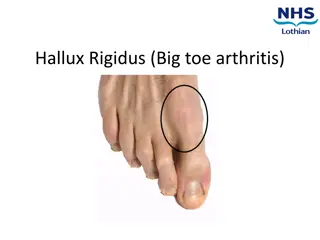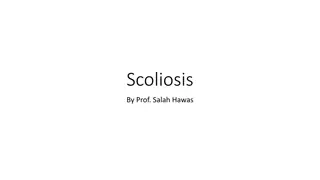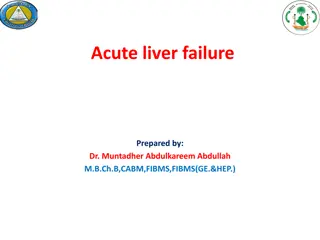Understanding Urolithiasis: Causes, Diagnosis, and Management
Urolithiasis, commonly known as kidney stones, has evolved over the years with changes in patterns and risk factors. This condition can affect different parts of the urinary tract and is influenced by factors like dietary deficiencies, urinary solute imbalances, and inadequate drainage. Various types of stones can form due to factors like hypercalciuria, hyperoxaluria, and hyperuricosuria. Infections with urea-splitting organisms can also contribute to stone formation. Early detection and appropriate management are crucial in treating urolithiasis effectively.
Download Presentation

Please find below an Image/Link to download the presentation.
The content on the website is provided AS IS for your information and personal use only. It may not be sold, licensed, or shared on other websites without obtaining consent from the author. Download presentation by click this link. If you encounter any issues during the download, it is possible that the publisher has removed the file from their server.
E N D
Presentation Transcript
Dr. Farhanul Huda Associate Professor Dept of Surgery AIIMS Rishikesh
A disease described in antiquity by many observers. Mentioned in Oath of Hippocrates. Over last 150 years, pattern of stone disease has changed . Lower tract urate calculi still a problem in the third world.
Urolithiasis denotes stones originating anywhere in the urinary tract, including the kidneys and bladder. NEPHROLITHIASIS. URETEROLITHIASIS. CYSTOLITHIASIS.
ETIOLOGY Dietetic Deficiency of vitamin A causes desquamation of epithelium. The cells form a nidus on which a stone is deposited. Altered urinary solutes and colloids Dehydration increases the concentration of urinary solutes Reduction of urinary colloids, which adsorb solutes, or mucoproteins, which chelate calcium, might also result in a tendency for crystal and stone formation.
Decreased urinary citrate The presence of citrate in urine, 300 900 mg 24 h 1 as citric acid, tends to keep otherwise relatively insoluble calcium phosphate and citrate in solution. Renal infection with urea-splitting streptococci, staphylococci and especiallyProteus spp.
Inadequate urinary drainage and urinary stasis Stones are liable to form when urine does not pass freely. Prolonged immobilisation Immobilisation from any cause results in skeletal decalcification and an increase in urinary calcium.
HYPRECALCIURIA Idiopathic hypercalciuria, Primary hyperparathyroidism, Renal tubular acidosis, sarcoidosis and vitamin D intoxication. HYPREOXALURIA Primary hyperoxaluria ,Enteric hyperoxaluria, Toxic hyperoxaluria HYPERURICOSURIA Urinary Acidification and Alkalinization
Infection with urea splitting organisms. The urea is split to ammonia, which is hydrolyzed to ammonium hydroxide, raising urine pH to 8 to 9, struvite precipitates. Struvite stone disease has been called "stone cancer" The stones tend to be very large (staghorn), and frequently result in renal damage, but patients may be relatively symptom free until the stone occupies entire collecting system.
Cystinuria An inborn error of metabolism characterized by increased urinary excretion ofcystine,ornithine, lysine, arginine (COLA), due to a defect in renal tubular reabsorption of these amino acids. Cystine is insoluble and precipitates in concentrated urine. The stones are large ,radiolucent and recurrent.
Some drugs (triamterene, some of the older sulphas) can be metabolized to insoluble compounds which can precipitate in urine. The carbonic anhydrase inhibitor, acetazolamide, causes a combined Type 1 and Type 2 RTA which may result in nephrolithiasis.
Types of renal calculus Oxalate calculus (calcium oxalate) Irregular in shape. Covered with sharp projections, which cause bleeding. The surface of the calculus is discoloured by altered blood. Is hard and radiodense.
Phosphate calculus It is smooth and dirty white. Tends to grow in alkaline urine, especially when urea-splitting organisms are present. It may enlarge to fill most of the collecting system, forming a staghorn calculus. Even a very large staghorn calculus may be clinically silent for years. Presents with haematuria, urinary infection or renal failure. Easy to see on radiographic films.
Uric acid and urate calculi These are hard, smooth and multiple. They vary from yellow to reddish brown, multifaceted. Are radiolucent and appear on IVP as a filling defect, which can be mistaken for a tumour. The presence of uric acid stones is confirmed by CT.
Cystine calculus Associated with a congenital error of metabolism that leads to cystinuria. Hexagonal, translucent, white crystals of cystine appear only in acid urine. They are multiple and may grow to form a cast of the collecting system. Pink or yellow when first removed, they change to a greenish colour when exposed to air. Cystine stones are radioopaque because they contain sulphur, and they are very hard.
Xanthine calculus Extremely rare. Smooth and round, brick-red in colour, and show lamellation on cross-section.
Clinical features Silent calculus UTI Uraemia may be the first indication calculi.
Pain MC symptom in 75% of people. Fixed renal pain is located posteriorly in the renal angle anteriorly in the hypochondrium, or in both. It may be worse on movement, particularly on climbing stairs.
Ureteric colic is an agonising pain passing from the loin to the groin. Typically, it starts suddenly causing the patient to writhe to find comfort. Pain resulting from renal stones rarely lasts more than 8 hours in the absence of infection. There is no pyrexia. The severity of the colic is not related to the size of the stone .
Haematuria Sometimes a leading symptom of stone disease. As a rule, the amount of bleeding is small. Pyuria Infection is dangerous when the kidney is obstructed. As pressure builds in the dilated collecting system, organisms are injected into the circulation and a life- threatening septicaemia can quickly develop. The mechanical effect of stones irritating the urothelium may cause pyuria even in the absence of infection.
Radiography The KUB film shows the kidney, ureters and bladder. An opacity that maintains its position relative to the urinary tract during respiration is likely to be a calculus. Opacities that may be confused with renal calculus Calcified mesenteric lymph node Gallstones or concretion in the appendix Tablets or foreign bodies in the alimentary canal Phleboliths Ossified tip of the 12th rib Calcified tuberculous lesion in the kidney Calcified adrenal gland
Excretion urography Also called IVP, is a radiological procedure used to visualize abnormalities of the urinary system, including the kidneys, ureters, and bladder.
Procedure-IVP An injection of x-ray contrast medium is given I/V. The contrast is excreted via the kidneys, and the contrast media becomes visible on x-rays almost immediately after injection. X-rays are taken at specific time intervals to capture the contrast as it travels through the different parts of the urinary system. This gives a comprehensive view of the patient's anatomy and some information on the functioning of the renal system.
An IVP can be performed in either emergency or routine circumstances. Emergency IVP For patients who present to the A&E, with severe renal colic and a positive hematuria test. Patients with a positive find for kidney stones but with no obstruction are usually discharged with a follow-up appointment with a urologist. Patients with a kidney stone and obstruction are usually required to stay in hospital for monitoring or further treatment.
Contraindications-IVP Metformin should be to stoped 48 hours pre and post procedure. ARF/CRF. Known allergy to contrast medium.
Contrast-enhanced computerised tomography CT has become the mainstay of investigation for acute ureteric colic. Ultrasound scanning Ultrasound scanning is of most value in locating stones for treatment by extracorporeal shock wave lithotripsy (ESWL).
URETERIC CALCULUS A stone in the ureter usually comes from the kidney. Most are single small stones that are passed spontaneously. Clinical features Ureteric colic Intermittent attacks of colic. As the stone progresses to the lower ureter, loin pain is typically referred more to the groin, external genitalia and the anterior surface of the thigh. When the stone is in the intramural ureter, the pain can be referred to the tip of the penis. Strangury, the painful passage of a few drops of urine, typically occurs with the stone in the intramural part of the ureter.
Haematuria Almost every attack of ureteric colic is associated with microscopic haematuria, which lasts for a day or so. More profuse bleeding is uncommon and should raise the suspicion that the colic is due to passage of a clot.
When the stone becomes impacted, the attacks of colic give way to a more consistent dull pain, often felt in the iliac fossa. The pain may be increased by exercise and lessened by rest. Severe renal pain subsiding after a day or so suggests complete ureteric obstruction. If obstruction persists after 1 2 weeks, the calculus should be removed because prolonged distension of the kidney will eventually lead to atrophy of the renal parenchyma.
Impaction There are five sites of narrowing where the stone may be arrested What are those?
Abdominal examination Tenderness and some rigidity over some part of the course of the ureter. On the right side is to distinguish from ?? The presence of haematuria does not rule out appendicitis, because an inflamed appendix can give rise to a local ureteritis.
Imaging Plain abdominal radiograph. Intravenous urography. Spiral CT scan. Cystoscopy.
CONSERVATIVE MANAGEMENT Mainstay is the forced increase in fluid intake to achieve a daily urine output of 2 liters . Increased urine output has two effects- 1. Mechanical diuresis 2. The dilute urine alters the supersaturation of stone components. Dietary Recommendations
The primary goal of is to achieve maximal stone clearance with minimal morbidity. Four minimally invasive treatment modalities are available: SWL, PNL, ureteroscopy, and laparoscopic stone surgery. Recent advancements in endoscopic technology and surgical technique have dramatically reduced the need for open surgical procedures to treat patients with renal and ureteral calculi.
About 80% to 85% patients can be treated with SWL. Factors associated with poor stone clearance rates: large renal calculi (mean, 22.2 mm), 2. stones within dependent or obstructed portions of the collecting system, 3. stone composition (mostly calcium oxalate monohydrate and brushite), 4. obesity or a body habitus that inhibits imaging, 5. unsatisfactory targeting of the stone. 1.
Management of small stones Most small urinary calculi will pass spontaneously . The presence of infection in an obstructed upper urinary tract is dangerous and is an indication for urgent surgical intervention.
Percutaneous nephrolithotomy Placement of a hollow needle into the renal collecting system through the soft tissue of the loin and the renal parenchyma. the nephroscope is inserted through the track to visualise the stone. Small stones are grasped under vision and extracted. Larger stones are fragmented and removed in pieces. The aim is to remove all fragments if possible, and this may take some time if the calculus is large. When the operation is over, a nephrostomy drain is left in the system.
PCNL is sometimes combined with ESWL in the treatment of stag-horn calculi. Complications of PCNL include (1) haemorrhage from the punctured renal parenchyma (2) perforation of the collecting system (3) perforation of the colon or pleural cavity during placement of the percutaneous track.
Extracorporeal shock wave lithotripsy (ESWL) A urinary calculus has a crystalline structure. Bombarded with shock waves of sufficient energy it disintegrates into fragments. As shock waves are poorly transmitted through air, both the patient and the shock-wave generators were immersed in a bath of water. Modern ESWL machines do not have a water bath . The shocks are generated by piezoelectric cells.
When ESWL is successful, the stone fragments must pass down the ureter. Ureteric colic is common after ESWL. The bulky fragments of a large stone may impact in the ureter, causing obstruction. To avoid this, a stent should be placed in the ureter so that the kidney can drain while the pieces of stone pass. Occasionally, impacted fragments have to be removed ureteroscopically . The principal complication of ESWL is infection.
Open surgery for renal calculi Pyelolithotomy- indicated for stones in the renal pelvis. Extended pyelolithotomy Nephrolithotomy Partial nephrectomy Nephrectomy
Treatment of bilateral renal stones Usually the kidney with better function is treated first unless the other kidney is more painful or there is pyonephrosis, which needs urgent decompression. Silent bilateral staghorn calculi in the elderly and infirm may be treated conservatively. The patient should be encouraged to maintain a high fluid intake.
